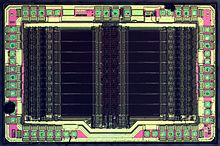|
Complex programmable logic device
  A complex programmable logic device (CPLD) is a programmable logic device with complexity between that of PALs and FPGAs, and architectural features of both. The main building block of the CPLD is a macrocell, which contains logic implementing disjunctive normal form expressions and more specialized logic operations. FeaturesSome of the CPLD features are in common with PALs:
Other features are in common with FPGAs:
The most noticeable difference between a large CPLD and a small FPGA is the presence of on-chip non-volatile memory in the CPLD, which allows CPLDs to be used for "boot loader" functions, before handing over control to other devices not having their own permanent program storage. A good example is where a CPLD is used to load configuration data for an FPGA from non-volatile memory.[1] DistinctionsCPLDs were an evolutionary step from even smaller devices that preceded them: PLAs (first shipped by Signetics) and PALs. These in turn were preceded by standard logic products, which offered no programmability and were used to build logic functions by physically wiring several standard logic chips (or hundreds of them) together (usually with wiring on a printed circuit board or boards, but sometimes, especially for prototyping, using wire wrap wiring). The main distinction between FPGA and CPLD device architectures is that CPLDs are internally based on a collection of PLDs accompanied by a programmable interconnection structure, while FPGAs use logic blocks. See also
ReferencesWikimedia Commons has media related to Complex programmable logic devices.
|